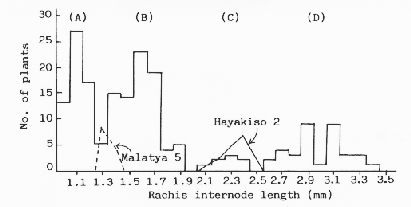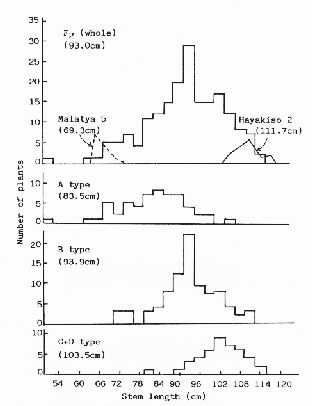

A two-rowed, covered barley variety, Malatya 5, collected in Turkey by Kyoto University Hindu-Kush Expedition, is characterized by extremely dense or compact spike and short stem. Mode of inheritance of the extremely dense spike character was investigated using a cross between Malatya 5 and Hayakiso 2 (Japan) which was known to have a dense spike gene, l on chromosome 1.
Frequency distribution in the F2 of length of rachis internode (Fig. 1) revealed a clear tetra-modal curve, and the four groups of plants could easily be classified; (A) having further compact spike than that of Malatya 5, (B) having the same extremely spike as Malatya 5, (C) having ordinarily dense spike as Hayakiso 2, and (D) having lax spike.
The number of F2 plants belonging to the A, B, C, and D groups were 58, 84, 8, and 36, respectively, which fitted well to the segregation ratio of 5:7:1:3 (Table 1). The result of F3 test indicated that eight F2 plants taken in the group C were all homozygous for Hayakiso genotype or ordinarily dense spike, while 21 F2 plants taken from group D showed two genotypic groups. Seven of 21 F2 plants were homozygous for the lax spike genotype, and the other plants were heterozygous producing plants of both Hayakiso and lax spike phenotype. Furthermore, the F3 lines which segregated lax spike plants were not found in the F3 test of the group A. These facts suggested that genotypic constitutions of parental varieties and the F2 plants of four groups are as shown in Table 1, where dominant gene, D, tentatively named for extremely dense spike, and recessive gene for dense spike on chromosome I are epistatic to the gene L and the gene d for lax spikes, respectively.



The relation between spike density and stem length was studied further. As seen in Fig. 2, stem length of the F2 plants varied continuous between the parents values. Among the groups classified by spike density, frequency distribution regarding stem length shifted more or less toward longer stem in the order of groups A, B, and C+D. Consequently mean value of each group was about 10 cm more than the preceding group. The results suggested that, although stem length is mainly controlled by polygenes in this cross, the gene or genes for spike density also affect the stem length.
Furthermore, the results of an allelic test have indicated that D is allelic to or identical with the dominant genes for extremely dense spike involved in B.855 (USA) and Russian 31 (USSR).*
*Editor's note: The gene symbol D has been assigned to several other morphological traits. Dr. U. Lunaqvist has suggested that an allelic series, based on the gene symbol Zeo and the name zeocripton, be established for the dominant dense spike mutants.